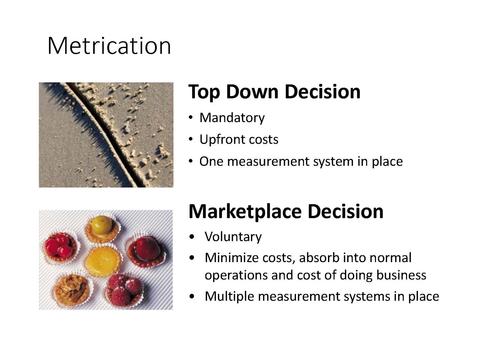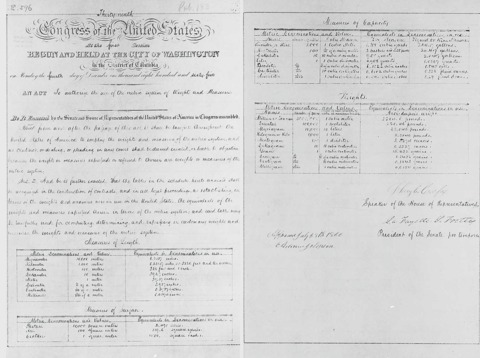U.S. Metrication Frequently Asked Questions (FAQs)

Metric transition, metric conversion, or metrication are terms used to describe moving from use of local, traditional, or customary units of measure to the SI. Historically, two major approaches have been used: top down or market place decision (Figure 1). A top down decision is usually mandatory. Costs expended by an organization are upfront. Benefits are timely. After the change, only one measurement system is in place. The likelihood of interacting with or encountering legacy measurement systems outside their organizational control may remain for some time. A market place decision is usually voluntary. This approach minimizes upfront costs, which are absorbed into normal operations and represent a “cost of doing business.” A significant downside is that it can be a longer-term process that comes with a major risk. Working with multiple measurement systems at the same time can lead to errors and inefficiencies.

Manufacturers develop products and services to meet diverse customer needs and are in the best position to determine when/if metric adoption is good decision for their business; a factor that has shaped U.S. policy to permit either SI or U.S. customary measurements. This places the decision and pace of metric use in the hands of companies as well as the consumers who purchase their products. Industry sectors are moving toward increased SI use at different tempos. Manufacturers that rely on international supply chains are at the high end of the Metric Continuum. However, customary measurement practices continue to be necessary for many small businesses that engage only in intrastate commerce at a local scale.
When U.S. companies begin the metrication process internally, they start by analyzing the costs and benefits, including any long term impacts of not converting to SI measurements. Organizations know their business model and make the best decision for their organization. The inability to produce products, communicate, or provide services using the SI to national and international consumers that prefer or require metric measurements can place an organization at a competitive disadvantage.
While it’s true that SI use is mandatory in some countries and voluntary in others, all countries have recognized and adopted the SI, including the United States. There are still countries that are amending their national laws to adopt a mandatory metric policy and others pursuing voluntary metrication. From a technical perspective, it’s impossible to avoid using the metric system as all measurement units (including U.S. customary units) are defined in terms of the SI. The NIST blog article, Busting Myths about the Metric System, discusses some common misconceptions about the status of U.S. metrication.
Beginning in the 1890s, governments around the world began a concerted effort adopt the metric system by mandatory government adoption. In the 1960s, a list of metric counties with mandatory laws started to appear in metrication literature (Example List: NBS Misc. Pub. 286:1967, Units of Weights and Measures, page 6). A prevalent idea at the time was that if a country didn’t have a mandatory metric law (or was committed to mandatory metric) then it was “non-metric.” The depiction of “uncommitted countries” morphed into “non-metric” countries and was used as a way to criticize the U.S. voluntary approach to metrication.

In 1971, the National Bureau of Standards (NBS, now NIST) published the combined reports of the U.S. Metric Study, which also contained a map depicting a list of countries “uncommitted” to mandatory metrication (Figure 2). The U.S. and other countries listed were described as “Islands in a Metric World.” The flaw with this perspective was that the concept didn’t recognize that the U.S. had been "metric" since 1866, when the metric system was first legalized. A few years after the U.S. Metric Study was published, Congress passed the Metric Conversion Act adopting voluntary metrication that was signed into law by President Ford in 1975. Over time, various versions of the map/country list became integrated into even more metrication publications. The Central Intelligence Agency (CIA) Factbook is one of the often cited sources of the U.S./Liberia/Burma metric myth. The first unclassified version of the CIA Factbook was published around the same time the U.S. Metric Study. It’s likely that the original list of “uncommitted” countries was incorporated, then edited as countries adopted mandatory metric laws. Over the years, many web resources have quoted the CIA Factbook, perpetuating the metric myth and elevating the map to a pop culture meme. The U.S. metrication status is best described as a Metric Continuum.
One the most significant arguments for the United States moving away from the current dual measurement system to the exclusive use of the SI is a reduction of measurement unit conversion errors. At best, the price of unit conversion calculation errors are expensive. At worst, the consequences can be a matter of life and death. Unfortunately, there are many documented examples of unit mix-ups, including the 1999 crash of the $125 million NASA Mars Climate Orbiter spacecraft. NASA later determined that the root cause of the erroneous trajectory and velocity calculations were due to a failure of the contractor to use SI units of force (Newton, N), as specified by NASA, within the coding of a ground software file used in trajectory models.
Using metric practices is a “best practice.” Many U.S. industries have quietly gone metric in response to internal or market demands. For example, companies like Caterpillar, General Motors, Xerox, IBM, and Kodak have been metric for years because they export products and use international supply systems. Learn more about how going metric has paid off for a wide variety of organizations.
Significant metrication has occurred when emerging technologies or new product lines enter the U.S. marketplace, developed from the bottom up using metric measurement practices. New technology is a driver of metric adoption. Many manufacturers implement metric transition when new projects are brought online because this is when SI measurements are integrated most efficiently (i.e., as a normal cost of doing business rather than an added expense). Most modern equipment has dual measurement functions and capabilities, providing the user with data in either measurement system.
Legal units of measurement are those that are required or permitted by law or regulation that NIST has published in the Federal Register.
All measurement units are defined in terms of the International System of Units (SI), initially described in the International Bureau of Weights and Measures (BIPM) SI Brochure and interpreted by NIST into Special Publication (SP) 330 and Special Publication (SP) 811. The Federal Register Notices (FRNs) refer users to these two official publications (see the current online editions). For example:
- Interpretation of the International System of Units (the Metric System of Measurement) for the United States (2008)
- Deprecation of the United States (U.S.) Survey Foot (2020)
The information in current online editions of SP 330 and SP 811 (including Appendix B, Conversion Factors) are subsequently published in other documentary standards such as IEEE/ASTM SI 10 or NIST Handbook (HB) 44, Appendix C, General Tables of Units of Measurement. Additional Unit Conversion resources are available on our webpage.
Non-SI units are defined in terms of the SI. NIST recommends the use of the term “U.S. customary system of measurement” to describe the collection of non-SI measurement units used in the United States; it samples from three early systems (e.g., Apothecary, Troy, and Avoirdupois) that describe mass, volume (capacity units – dry and fluid), and length units. The significant differences in scale between British (Imperial) and U.S. customary units are described in NIST Handbook 44, Appendix B. The U.S. customary system should not be described with the terms “Imperial,” “British,” or “inch-pound.”
CONNECTIONS
- OWM Frequently Asked Questions (FAQs)
- Metric Policy
- Metric Publications
- Expanding Package Labeling Options to Benefit U.S. Exports
- Training and Professional Development
- U.S. Survey Foot Deprecation
EXPLORE THE METRIC PROGRAM
Everyday with Metric | National Metric Week | NEST-R (STEM Registry) | NIST Education Resources | SI Education & Training | SI Units | U.S. Metrication


